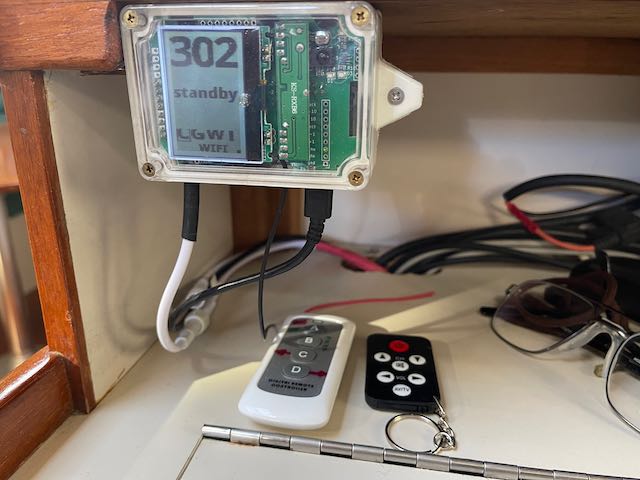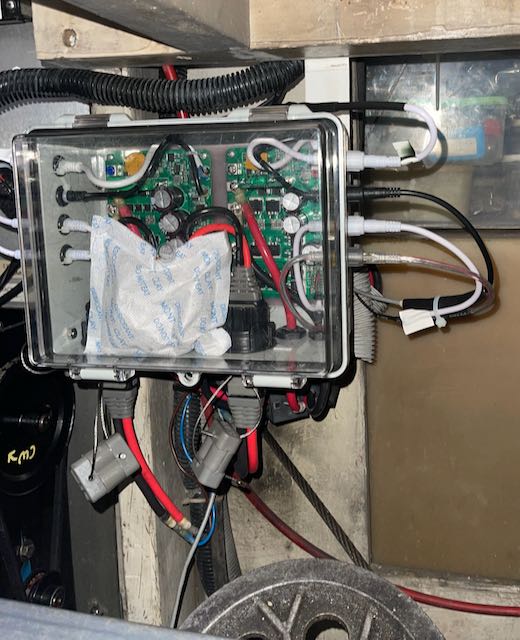Posts: 11
Threads: 4
Joined: Mar 2022
Reputation:
0
I've installed TinyPilot on my Sundeer 56 sailboat to replace an old WH autopilot. The WH autopilot drove two motor controllers/motors/hydraulic pumps. The hydraulics are industrial, powerful and very capable. I recently had the hydraulics rebuilt. I've built a box to house two 30 amp motor controllers from Sean and those are wired up and work. Photos below.
TinyPilot properly communicates with one motor controller which is sufficient for normal weather. My project will be to add a second serial port and modify Pypilot to properly communicate with both motor controllers so that I can run both pumps at the same time for heavy weather sailing. I've been using the system for about a month now and will post a couple of suggestions for discussion. I'm running TinyPilot version 0.24. I'll upgrade to the latest build soon.
When AP is off I'd like it to be really off. TinyPilot says standby and the remotes don't do anything which is the behavior I expect in Standby. I was very surprised when AP was off and I accidentally hit the << button on the web browser interface on my phone and the wheel turned 270 degrees and the boat turned fast at 6 knots. I would like Manual to be a mode just like Compass, GPS, Wind. Before turning AP on I decide which mode I want, typically Compass, but possibly Manual. In Manual mode the browser interface and remotes should all behave the same with direct control of the wheel but with much finer control than with present Standby.
Ideally Manual mode would read the rudder angle indicator and maintain a rudder angle. If I'm sailing upwind in steady wind with the boat well balanced this would be equivalent to steering with say one spoke down. In good conditions the boat will sail herself like this, maintaining a steady wind angle and speed with no steering required. I can engage the hydraulics with AP off to hold the wheel at a fixed angle, but after a time as the sea works the rudder and fluid leaks past the ram seals the wheel slowly moves and I have to reset it. PyPilot could easily maintain the rudder angle using minimal power. PyPilot would be controlling rudder angle rather than compass bearing or wind angle. TinyPilot display would show rudder angle.

TinyPilot at nav station.

Two motor controllers in box beside hydraulic pump near rudder quadrant.
Posts: 47
Threads: 7
Joined: Oct 2021
Reputation:
0
2022-10-10, 09:22 AM
(This post was last modified: 2022-10-10, 01:00 PM by kniven.)
Yes. I agree. But I'm not sure if it's really needed. In which situations would you want to keep the rudder angle constant, and allowing for course changes? Would probably result in nice, perfect circles. On calm days.
I do, however, agree that the use user interface/remote controls allow for some "surprises", if you do not pay attention. I recently was motoring along in 6 knots, when a drop of water (my lazybag tends to keep some trapped rain water inside) hit the ipad screen, resulting in a "tack to starboard" command. This was luckily in open water, and it took me some thinking before I realized what had just happened.
I don't know if there would be a fail safe solution to that sort of issues. For the web interface, maybe a "Execute command" button would make sense... In that way, you could prepare your course change upfront, and confirm your choice within a reasonable time limit (10-30 seconds).
Posts: 2,184
Threads: 20
Joined: Jun 2016
Reputation:
64
Very interesting idea to have a "manual" mode rather than manual control in standby. This mode steering to rudder angle is obviously really useful for setups that can slip or otherwise backdrive the motor from weather helm, but not very useful for setups that dont have rudder angle and can't.
We are getting into the realm of needing custom configurations. A configuration to "unlock" normally hidden modes, like this one, or to support multiple motor controllers. So although the default setup would not provide them, at worst, modifying a configuration file, or eventually just selecting them in the browser configuration would do all this.
A separate issue is re-configuring the web layout to have different "themes" or something to replace the buttons, provide different buttons or limit accidents (like tacking) from the main control screen. Perhaps some users would prefer several taps to tack for example, or others would like more or fewer main control buttons. Still more may prefer gestures to do things.
I need to divide the idea into what is specific to just the web control as opposed to what will affect the core of pypilot (and require support in all interfaces) like new modes.
As for more modes, there are currently 4: C, G, W, T for compass, gps, wind and true wind. I realize true wind is not really that useful to most users, and you may prefer M, or N modes as mentioned. My issue is, there is not enough space on the screen if more than 4 are available... should it pan across them then? I guess this can be made to work.
Posts: 2
Threads: 0
Joined: Oct 2023
Reputation:
0
First to introduce myself:
Owning a Stern50 aluminum ketch, indeed with an old WH AP, which still works by the way, having done a circum nav once and about to start a second.
During the build of Stern50 I read the Dashew books, so I recognize the Sundeer.
I also recognize the following in the TopicStarter text:
Quote:
Ideally Manual mode would read the rudder angle indicator and maintain a rudder angle. If I'm sailing upwind in steady wind with the boat well balanced this would be equivalent to steering with say one spoke down. In good conditions the boat will sail herself like this, maintaining a steady wind angle and speed with no steering required. I can engage the hydraulics with AP off to hold the wheel at a fixed angle, but after a time as the sea works the rudder and fluid leaks past the ram seals the wheel slowly moves and I have to reset it. PyPilot could easily maintain the rudder angle using minimal power. PyPilot would be controlling rudder angle rather than compass bearing or wind angle. TinyPilot display would show rudder angle.
Unquote
That's exactly how a Dashew sails upwind:
Trim the sails, a tiny bit weather helm, und the boat sails itself without helmsman or AP. We sailed from Sicily to Greece like this! (The Stern50 is not a Dashew, but has some design thoughts incorporated)
So what the TS asked is recognisable :
Not to control the course (since the boat is already steering to wind itself) but to control the rudder position. This position is part of the trim of the boat. True: when the wind picks up, a little bit more weather helm is needed for a new trim. Normally this trimming of our steering wheel is only one cm on a 5,6 full wheel turn HOH.
We are opting for the Pypilot as a backup for the WH indeed keeping the hydraulics.
Question:
Does the Pypilot takes the actual average weatherhelm position of the rudder as zero whilst controlling or does it sends the rudder home to absolute midships after course corection?
Question:
When pushing AUTO to start control by AP, does the Pypilot takes the actual rudder position as zero or does it first directly sends the rudder to midships?
Posts: 2,184
Threads: 20
Joined: Jun 2016
Reputation:
64
(2023-10-15, 10:57 PM)RonaldL Wrote: We are opting for the Pypilot as a backup for the WH indeed keeping the hydraulics.
Question:
Does the Pypilot takes the actual average weatherhelm position of the rudder as zero whilst controlling or does it sends the rudder home to absolute midships after course corection?
Question:
When pushing AUTO to start control by AP, does the Pypilot takes the actual rudder position as zero or does it first directly sends the rudder to midships?
Most boats will hold a course upwind locked, however depending on the sea state, and boat this may not be a very efficient way to sail them. Typically there are not a lot of corrections needed but I understand with this particular boat, you are essentially using the sails themselves as the sensor and locking the rudder may actually prove better especially without a wind sensor. I would wonder if you could somehow just install a mechanical brake to the rudder to lock it to avoid hydraulic leakage, and even if the pilot does as well, this would be a useful backup system.
it does not send the rudder to midships. the basic pilot does not rely on the rudder sensor. It is used mostly for user feedback and as a nice way to detect the rudder end of movement. In this sense, even if the rudder feedback failed you might not notice it. The errors accumulated from lack of rudder feedback are an order of magnitude below the noise the pilot must compensate anyway.. but
there is an "absolute pilot" you can use instead of the basic pilot which does require rudder feedback, but even it will not return the rudder to midships, instead it computes the optimal rudder angle based on course error and rate of change.. so yes if you are on course and the boat is not yawing at all, this pilot would command a rudder angle of zero, which means it could suffer from a mis calibrated rudder.
the only time the pilot specifically sends the rudder midships from a command is if in manual control you press the "center" button which most users never see because it only exists if you have rudder feedback.
Posts: 2
Threads: 0
Joined: Oct 2023
Reputation:
0
Thanks for the feedback...
|






